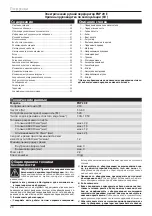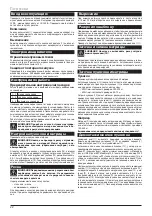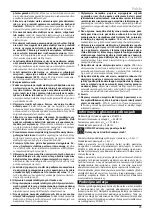
English
12
Electric hand punch ENP 20 E
Original operating manual (EN)
Description of the device
1 .......Sliding switch button
2 .......Gearing section
3 .......Engine section
4 .......Bonnet
5 .......Bonnet screw
6 .......Controller
7 .......Air vents
8 .......Movable supply
9 .......Matrix
10 .....Punch guide
11 .....Clamp bolt
12 .....Punch
13 .....Connecting hinge
14 .....Eccentric spindle
15 .....Cover ring
16 .....Peg
17 .....Beam
18 .....Bushing guide
19 .....Peg
*) Depicted or displayed accessories need not necessarily be-
come the integral part of delivery.
Technical Specification
Model
ENP 20 E
Voltage (V)
230
Mains frequency (Hz)
50–60
Power input (W)
520
Number of lifts at no load (l.p.m)
300–1 950
Thickness of cut sheet metal:
Steel 400 N/mm
2
(mm)
max. 2.0
Steel 600 N/mm
2
(mm)
max. 1.5
Steel 800 N/mm
2
(mm)
max. 1.0
Aluminous 250 N/mm
2
(mm)
max. 2.5
Cutting speed at sheet metal thickness of 2 mm
and 400 N/mm
2
resistance (m.p.m)
1.2
Minimum cut radius
Internal shape (mm)
min. 4
External shape (mm)
min. 0
Weight (kg)
2.2
Class of protection
II /
General Power Tool Safety Warnings
WARNING! Read all safety warnings and all instruc-
tions.
Failure to follow the warnings and instructions
may result in electric shock, fire and/or serious injury.
Save all warnings and instructions for future reference!
The term “power tool” in the warnings refers to your mains‑operat‑
ed (corded) power tool or battery‑operated (cordless) power tool.
1) Work area safety
a)
Keep work area clean and well lit.
Cluttered or dark areas
invite accidents.
b)
Do not operate power tools in explosive atmospheres, such
as in the presence of flammable liquids, gases or dust.
Pow-
er tools create sparks which may ignite the dust or fumes.
c)
Keep children and bystanders away while operating a pow-
er tool.
Distractions can cause you to lose control.
2) Electrical safety
a)
Power tool plugs must match the outlet. Never modify the
plug in any way. Do not use any adapter plugs with earthed
(grounded) power tools.
Unmodified plugs and matching
outlets will reduce risk of electric shock.
b)
Avoid body contact with earthed or grounded surfaces,
such as pipes, radiators, ranges and refrigerators.
There is
an increased risk of electric shock if your body is earthed or
grounded.
c)
Do not expose power tools to rain or wet conditions.
Water
entering a power tool will increase the risk of electric shock.
Table of contents
Description of the device ..................................................................12
Technical Specification .....................................................................12
General Power Tool Safety Warnings .............................................12
Information about noise level and vibrations ..............................13
Double insulation ..............................................................................13
Use .......................................................................................................13
Putting into operation ......................................................................13
Motor electronics ...............................................................................13
Work instructions ..............................................................................14
Punch and matrix adjustment ........................................................14
Cutting ................................................................................................14
Punching.............................................................................................14
Punching using a template ..............................................................14
Sharpening and replacement of matrix ........................................14
Plunger and matrix sharpening ......................................................14
Plunge dismantling and mounting ................................................14
Matrix dismantling ...........................................................................14
Beam dismantling .............................................................................14
astening the tool head .....................................................................15
Maintenance and service .................................................................15
Storage ................................................................................................15
Environmental protection ................................................................15
Warranty .............................................................................................15
Certificate of Conformity ..................................................................15













































